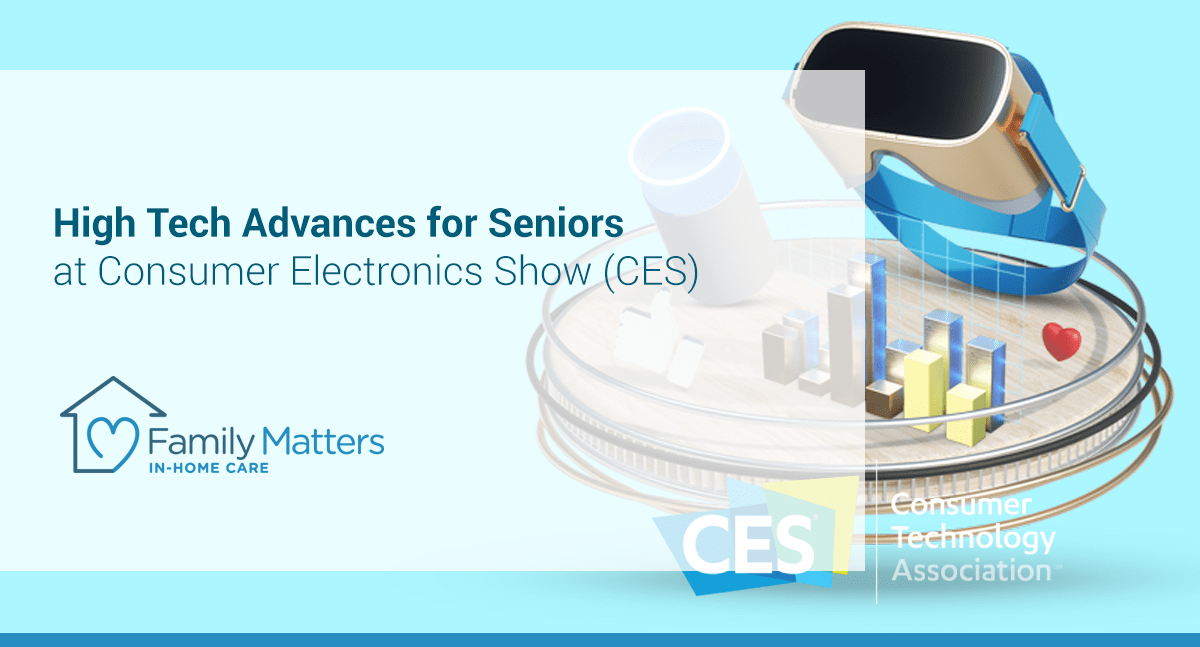
High Tech Advances for Seniors at Consumer Electronics Show (CES)
The Consumer Electronics Show (CES) is the largest technology exhibition in the world.
This year it featured flying taxis, self-rolling suitcases, holograms, and for the first time, a boat load of devices designed to help seniors. It’s a reflection of the power and size of the burgeoning baby boomer population. The U.S. Census Bureau estimates that by the year 2050, 80 million Americans will be over the age of 65; that’s one in every five people in the U.S.
If the tech industry is designing for them, it’s because it’s good business. As seniors adopt the technology, it’s good for their health.
Health, wellness, and remote monitoring was the focus of many of the devices. Here is an overview of some of them.
- A smartwatch with a blood pressure monitor: The monitor works the same way as a standard blood pressure monitor cuff used by the nurse in a doctor’s office and the hospital. It’s also approved by the Food and Drug Administration (FDA). It may result in truer readings because it can take them frequently throughout the day and avoids false high readings caused by the stress of being at the doctor’s office or in the hospital.
- A wheelchair that comes to you: The WHILL electric wheelchair is called an Autonomous Drive System. You can summon it via app, and the wheelchair drives itself to you. The first application is in airports, where there is increasing demand for porters and valets who can transport individuals through the airport via wheelchair. The WHILL can complete the “last mile of transportation”, transporting people from check-in to the gate. Future applications will include use in large hospitals, theme parks, and shopping malls.
- At-home medical monitors: BPM Core is an in-home blood pressure cuff that measures blood pressure and heart rate, and also takes an electrocardiogram of the heart. It has a digital stethoscope that can detect irregularities like atrial fibrillation, arrhythmia, and potentially dangerous types of heart disease. The device syncs with a smart phone and sends results to an app.
- Advanced hearing aids: Exhibitors at CES showed hearing aids designed to improve on current technology. Some were powered by fuel cells instead of batteries, while others use Artificial Intelligence to automatically adjust hearing settings.
- Widex hearing aids use a fuel cell that re-energizes itself in 20 seconds, versus the three to six hours it takes to recharge hearing aid batteries.
- The hearing aid manufacturer Oticon has developed Kaizn, that uses Artificial Intelligence to know the wearer’s surroundings and automatically adjusts the hearing aid settings to meet them. According to Oticon, “Kaizn collects and analyzes data about an individual’s hearing aid use and listening environments to learn their behaviors and hearing preferences, and ultimately provide real-time hearing aid recommendations and adjustments.”
- Smart clothing: Chronolife has developed a wearable medical device in the form of a t-shirt. It’s lightweight and washable; made of cotton and lycra. According to the company, it can monitor six physical parameters and send the data to a secure cloud where it can be accessed by physicians. It can monitor things like heart and respiratory rates, breathing capacity, temperature, number of steps, and posture, which would allow it to detect falls.
A recent survey by the AARP shows that seniors welcome technology. In fact, it’s estimated that by the year 2030 they will spend $84 billion a year on various types of technology. The survey found:
- Those between 50 and 64 use smartphones as much as the average American: 83 percent have smartphones, 91 percent use computers
- 94 percent of people over 50 use technology to stay connected to friends and loved ones via text, email
- One-third of the over-70 group uses social media daily
- In one year, use of home assistants such as Amazon Alexa or Google Home almost doubled among people 50 and older, from 7 to 13 percent
- In 2018, virtual-reality devices became 44 percent more popular among those over 50
It’s good to see that innovative manufacturers are paying attention to the senior market. Technology can keep people safe at home as they age, improve the amount of data physicians have to improve outcomes, and generally make life easier, simpler and more connected.
If you or your family member is considering in-home care as part of a plan to age in place, contact Family Matters In-Home Care today for a free consultation. Our team is dedicated to supporting your family and helping older adults enjoy life in the comfort of their own home for as long as possible.
Some of the services offered by Family Matter In-Home Care include: Alzheimer’s & Dementia Care, Bed & Wheelchair Transfer Assistance, Companionship, Housekeeping & Meal Preparation, Personal Care, Recovery Care, and Transportation.
Serving the San Francisco Bay Area and Greater San Diego, Family Matter In-Home Care has offices throughout California including: Campbell, CA, Roseville, CA, San Marcos, CA, and San Mateo, CA.
